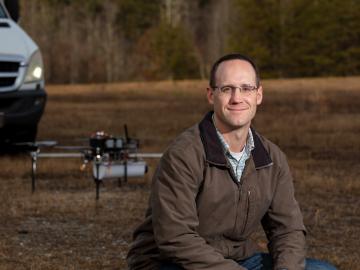
Filter News
Area of Research
- (-) Materials (38)
- (-) National Security (23)
- (-) Neutron Science (28)
- (-) Quantum information Science (9)
- Advanced Manufacturing (3)
- Biological Systems (1)
- Biology and Environment (37)
- Computational Biology (2)
- Computational Engineering (1)
- Computer Science (3)
- Electricity and Smart Grid (1)
- Energy Science (31)
- Functional Materials for Energy (1)
- Fusion and Fission (9)
- Fusion Energy (8)
- Isotope Development and Production (1)
- Isotopes (28)
- Materials for Computing (7)
- Nuclear Science and Technology (20)
- Nuclear Systems Modeling, Simulation and Validation (1)
- Supercomputing (85)
News Topics
- (-) Advanced Reactors (6)
- (-) Biomedical (21)
- (-) Biotechnology (2)
- (-) Cybersecurity (23)
- (-) Frontier (4)
- (-) Isotopes (13)
- (-) Quantum Science (25)
- (-) Space Exploration (5)
- 3-D Printing/Advanced Manufacturing (29)
- Artificial Intelligence (24)
- Big Data (8)
- Bioenergy (20)
- Biology (14)
- Buildings (6)
- Chemical Sciences (34)
- Clean Water (4)
- Composites (9)
- Computer Science (46)
- Coronavirus (15)
- Critical Materials (13)
- Energy Storage (39)
- Environment (26)
- Exascale Computing (2)
- Fossil Energy (1)
- Fusion (9)
- Grid (12)
- High-Performance Computing (10)
- Hydropower (1)
- Irradiation (1)
- ITER (1)
- Machine Learning (18)
- Materials (81)
- Materials Science (87)
- Mathematics (1)
- Microscopy (29)
- Molten Salt (3)
- Nanotechnology (44)
- National Security (35)
- Neutron Science (127)
- Nuclear Energy (22)
- Partnerships (15)
- Physics (31)
- Polymers (18)
- Quantum Computing (4)
- Security (12)
- Simulation (2)
- Summit (7)
- Transportation (21)
Media Contacts

To better understand how the novel coronavirus behaves and how it can be stopped, scientists have completed a three-dimensional map that reveals the location of every atom in an enzyme molecule critical to SARS-CoV-2 reproduction.

An international multi-institution team of scientists has synthesized graphene nanoribbons – ultrathin strips of carbon atoms – on a titanium dioxide surface using an atomically precise method that removes a barrier for custom-designed carbon

Scientists at ORNL and the University of Nebraska have developed an easier way to generate electrons for nanoscale imaging and sensing, providing a useful new tool for material science, bioimaging and fundamental quantum research.

Kübra Yeter-Aydeniz, a postdoctoral researcher, was recently named the Turkish Women in Science group’s “Scientist of the Week.”

Researchers at ORNL used quantum optics to advance state-of-the-art microscopy and illuminate a path to detecting material properties with greater sensitivity than is possible with traditional tools.

Two staff members at the Department of Energy’s Oak Ridge National Laboratory have received prestigious HENAAC and Luminary Awards from Great Minds in STEM, a nonprofit organization that focuses on promoting STEM careers in underserved

Horizon31, LLC has exclusively licensed a novel communication system that allows users to reliably operate unmanned vehicles such as drones from anywhere in the world using only an internet connection.

Pick your poison. It can be deadly for good reasons such as protecting crops from harmful insects or fighting parasite infection as medicine — or for evil as a weapon for bioterrorism. Or, in extremely diluted amounts, it can be used to enhance beauty.

From materials science and earth system modeling to quantum information science and cybersecurity, experts in many fields run simulations and conduct experiments to collect the abundance of data necessary for scientific progress.

Five researchers at the Department of Energy’s Oak Ridge National Laboratory have been named ORNL Corporate Fellows in recognition of significant career accomplishments and continued leadership in their scientific fields.


